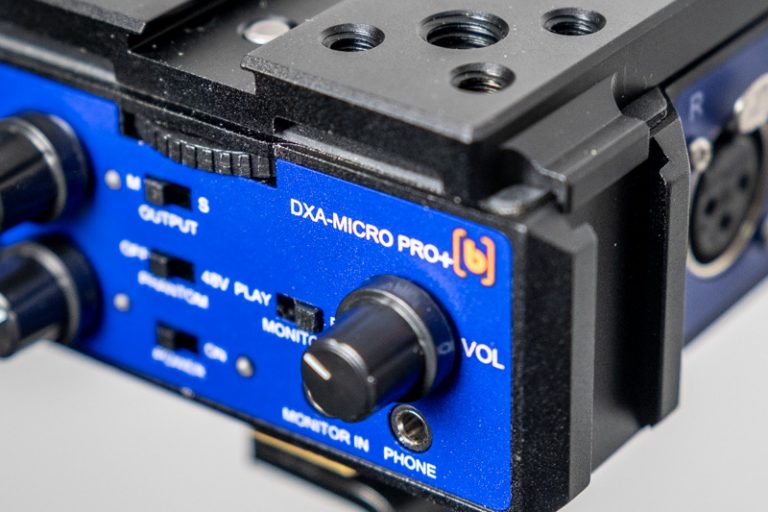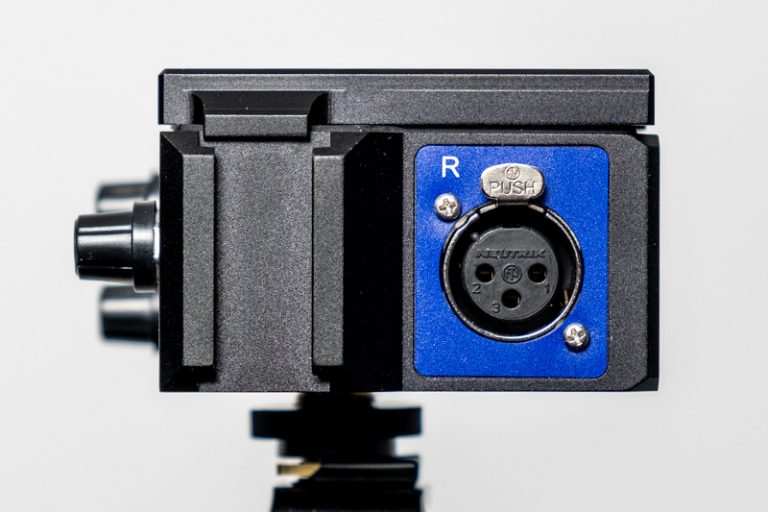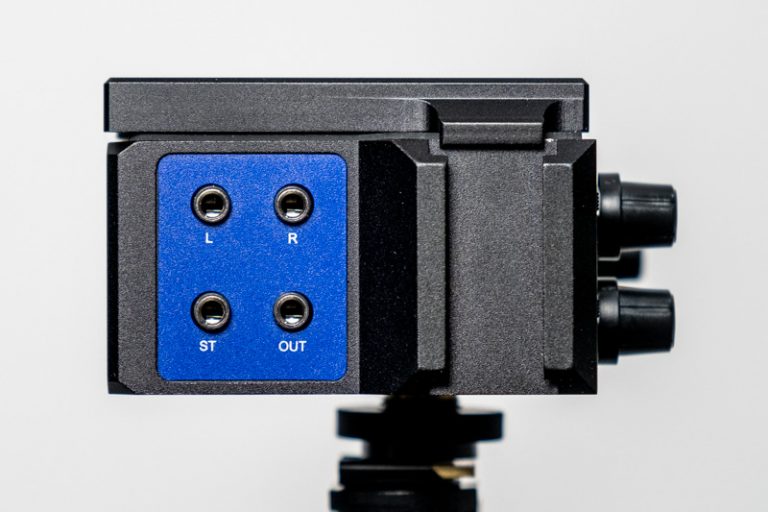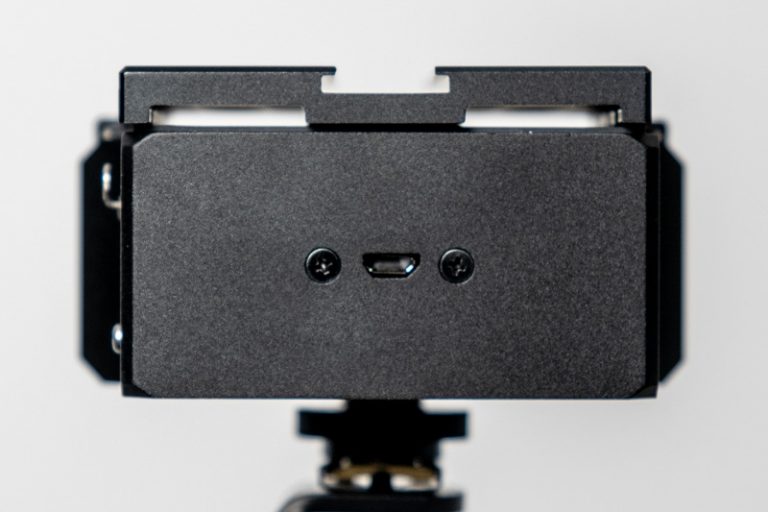DXA Micro Pro Plus. Investigating the updated version of Beachtek Audio’s much-respected camera audio interface.
2020 has been slow, leaving me, like countless others, with a fair amount of time on my hands. Rather than investing this in more Netflix viewing, I decided to catch up on a couple of personal projects. My list of things to do included further exploration of using my Fuji XT3 stills camera for video. I shoot most of my bread-and-butter video work with a fixed lens camcorder, the Panasonic AG-CX350. This camcorder fits really well with the blend of documentary, corporate, and ENG-style jobs I tend to do. I’m a solo shooter, so having one integrated unit for video and audio definitely suits my workflow. I’ve often used my XT3 for informal filming and for capturing the occasional B roll sequence. However, I never really had the time to get into using it more seriously. So I decided to do just that while I had a little downtime.
When I first started thinking about doing more filming with my XT3, I realised I’d need an audio adapter. So I got hold of a used Tascam DR60D Mk2, on eBay. While this is a great device in many respects, I found it a little oversized for mounting on a Fuji Body. I also found it quite fiddly to use in the field, due to its largely menu-based operation. Being spoiled by camcorders with good onboard audio facilities, I also found recording sound separately a bit of a pain. Consequently, I invariably ended up using the Tascam as a preamp rather than as a field recorder. With all this in mind, I decided that a simple external mic preamp for my XT3 would better suit my purpose.
What is it with DSLR/mirrorless cameras and audio?
Camera manufacturers love tempting us with the ever more impressive video capabilities of their DSLR and mirrorless line-ups. However, the unfortunate issue of relatively poor audio capability continues to mar their use. In recent years, several manufacturers have improved the audio bit depth of their higher-end systems from 16 bit to 24 bit. This improves the overall dynamic range, which is welcomed. However, the elephant in the room is relatively poor, often very noisy mic preamps on these cameras. In addition, their form factor excludes the use of XLR connections and the delivery of phantom power. This all adds up to be a real Achilles heel.
Two paths to audio salvation.
There are two approaches to overcoming these issues. The first of these has long since been an accepted part of the filmmaker’s workflow. Dual system recording captures audio separately from the camera. This is then synced to video during postproduction. Dual system recording has several advantages. First of all, a dedicated operator can take care of sound recording, while someone else concentrates on filming. In addition, discreet audio equipment can be made larger. This means it can accommodate more flexible connectivity and sound processing options.
However, dual system recording presents a number of difficulties for the solo shooter. It means added bulk and added weight, which often affects the balance and ergonomics of the camera rig. It can also increase stress in terms of ensuring two separate systems are running during filming. Synching separate audio and video files also adds complexity to postproduction.
The alternative to dual-system recording involves using an external mic preamp. These can accommodate XLR inputs and deliver phantom power. They also boost the input gain from an external microphone, reducing reliance on the camera preamp. This means that they can largely compensate for the audio inadequacies inherent in DSLR and mirrorless cameras. Pretty much all field recorders, such as those from Tascam, Zoom, and Sound Devices, can be used as an external preamp. But they can prove bulky, heavy, and expensive for this purpose. This is where devices like the Beachtek DXA-Micro Pro Plus come into their own.
Beachtek
US company, Beachtek Audio, enjoys a well-deserved reputation for producing high-quality external audio adapters. Their product range, though fairly small, includes devices for DSLR/mirrorless cameras. They also manufacture system-specific units for both Red and Arri users. Their niche is designing high-end preamps for in-camera audio recording, rather than external field recorders. The Beachtek product range can be found at https://beachtek.com.
DXA-Micro Pro+
The Beachtek DXA-Micro Pro Plus is a compact, high-quality external mic preamp (no recording facility). It connects to the mic input of a DSLR/mirrorless camera and expands the audio capability of that camera considerably. It offers fairly extensive high-quality audio connectivity. The unit has a range of mounting options. both for attaching it to a camera (or camera cage) and also for carrying peripheral devices. The latter can be used for attaching devices such as wireless receivers or an external monitor to a rig.
The Beachtek DXA-Micro Pro Plus is an updated version of the DXA Micro Pro. The original DXA Micro Pro has enjoyed an excellent reputation in the single shooter video community for some years. However, the original device suffers from a significant issue. It chews through 9v batteries like there’s no tomorrow. This means that users have to carry a number of spares to get through a day’s shooting. Not good for stress, productivity, or the environment.
The Pro Plus version houses an internal battery, offering up to 10 hours of battery life when Phantom power isn’t used. This is charged via a Micro USB port on the back panel, that replaces the battery door on the original version. The only other apparent difference between the two products is the inclusion of a removable cheese plate on top of the unit. This has 1/4″ and 3/8″ 20 threaded holes, as well as a very useful cold shoe channel running front to back.
Form Factor
The unit is quite small: 102 mm x 76 mm x 38 mm (L x W x H). The case is all metal, with only switches and knobs being made of plastic. All controls are neatly laid out on the front panel (no menus whatsoever) along with two stereo 3.5mm jacks. The rear panel contains the Micro USB power/charging port. Meanwhile, the two side panels contain all other connection ports and each also has a cold shoe mount.
On top of the unit, as already mentioned, there is a removable cheese plate containing a cold shoe mount. Removing this plate reveals a 1/4″ 20 threaded bolt, operated by a thumbwheel, for connection to a camera’s tripod mount. On the base of the unit is a cold foot for mounting the unit on top of a camera. This can be removed to reveal a 1/4″ 20 hole for mounting on a magic arm, quick release plate, or lighting stand. The cold foot testifies well to the overall quality of this unit, in that it is made of brass. Therefore it’s strong but incapable of scratching the chrome plating on your camera’s hot shoe; very thoughtful indeed. The whole unit is finished in blue and black with white legend, save the orange Beachtek logo. This makes it an extremely robust but attractive little package.

The DXA-Micro Pro+’s 450g (inc cheese plate) belies its very solid build quality; believe me, this thing really isn’t going to get damaged easily. My Tascam DR60D Mk2 is considerably larger and weighs in at well over 600g (including 4 AA batteries and under camera mount), but is positively fragile by comparison, as I recently found out….ooops!
DXA Micro Pro+ Connectivity
Inputs
- Single XLR input, supplying switchable 48v phantom power for condenser mics.
- Two mono 3.5mm jacks, supplying 3.5v ‘plug-in’ power for directly cabled lavaliere mics or prosumer grade ‘video’ mics.
- Single stereo 3.5mm jack, supplying 3.5v ‘plug-in’ power for prosumer grade stereo mic. I guess this jack could also take a stereo line input from an external audio mixer or similar. However, it would make more sense to go direct to the camera.
- Stereo 3.5mm jack for audio return from your camera (located on the front panel).
Outputs
- Stereo 3.5mm Jack output to the camera
- 3.5mm headphone jack (located on the front panel).



Front panel controls from L to R
- Hi/Low pad switch for each channel (to match up the gain range of each preamp to higher or lower mic output). Hi-gain = +30db, Low gain = +15db.
- Trim pot for each Chanel (for adjusting input gain within the range set by pad switches).
- Signal/overload LED (green = good signal/red = overload).
- Mono/Stereo switch. Directs input channels to either 1 mixed output or two separate outputs. Therefore the unit and can be used either for stereo recording or in mono with audio level bracketing.
- Phantom 48v power switch
- Unit on/off switch
- Battery level indicator green = good battery level, amber = intermediate battery warning, red = low battery warning.
- Monitor switch to select between monitoring input to preamp or output from camera. This can be used for camera input monitoring or for the playback of video clips.
- Camera audio return port and headphone Jack above which is the headphone volume control
- Also in the top center of the front panel is the wheel for securing the unit to 1/4 20 tripod mount on the base of a camera.
 Power
Power
- Built-in battery giving up to 10 hours usage on a full charge.
- Can be charged from or powered by an external power bank or similar.
A word on noise and why it’s something to worry about?
We’re often reminded that half of film or video is sound. Like it or not, we do notice noise, particularly in a world of squeaky-clean digital audio. Our enjoyment of and engagement with a movie will definitely be affected by incongruous background noise. This somehow seems to break the illusion that our storyteller is trying to create. Having a load of noise added to your audio track by poor mic preamps is, therefore, very undesirable. After all, generally speaking, the world around us doesn’t hiss!
To some degree, if noise is constant, we notice it less. However, we rarely shoot video as a continuous, unbroken shot, but rather as shorter clips. If the background noise in these clips doesn’t remain constant for any reason, we’re going to notice immediately. I guess the visual equivalent would be the colour of the sky changing inexplicably from shot to shot in the same scene; distracting, to say the least! So better to have as little background noise as possible to start with.
DXA Micro Pro+ comparative noise test
I decided to find out what self-noise difference I could expect between going direct to my XT3 and going via the Beachtek DXA-Micro Pro+. The XT3 isn’t renowned for having the worst preamp in the world, compared to other similar cameras. However, it’s certainly not the best either.
Firstly, I connected a Rode VideoMic Pro+ to an input on the DXA-Micro Pro+. I then took a line out and connected this to the mic port of the XT3. Next, I boosted the gain of the Beachtek to its maximum (+30db) and reduced the input gain of the XT3 to its minimum to compensate (conveniently -30db). I then recorded several seconds of silence. Finally, I recorded the Rode VideoMic Pro+ directly into the XT3; this time with the camera’s preamp set to 0db boost/cut.
Level playing field
Before I did the recordings, I tested the comparative gain structures by playing a sine wave from an iPhone app into the mic, in order to ensure parity. The level shown on the camera’s audio level meters was exactly the same for each signal path. This ensured that the noise comparison would be fair.
On playback, there was a clear increase in self-noise between the Beachtek signal path and the direct signal path. Audiometers on FCPX registered this as a 10db increase in noise when using the mic directly into the XT3. Bear in mind that, in theory, adding more electronics, cable, and connections, should increase the system’s self-noise. Therefore the noise-reducing effect of using a decent mic preamp is even more apparent.
Watch the video below to hear the results of the noise test
What’s in the box?
- All necessary cables are included with the unit:
- Two gold-plated curly mini-jack cables (audio output to camera and audio input from a camera).
- USB A to Micro USB for charging the internal battery. There’s no USB PSU included, but these days most homes and businesses are awash with them, so hardly an issue.
- A small hex key for removing the cold foot.
What I don’t like
Beachtek has gone to the trouble of using a three-stage LED battery indicator for power levels. This shows clearly when something is worthy of your attention, but not yet critical. I’m a little surprised, therefore, that they haven’t adopted a similar approach to the input level LEDs. As far as I understand them, they show only OK and bad! Even my ten-year-old IK Multimedia iRig has a three-stage input level indicator. That particular device is aimed primarily at mobile phone users rather than pros.
I can’t help but think that Beachtek has missed a trick by not including a second XLR input on this device. OK, I’ll admit that most of the time I only use a single SDC or shotgun mic. But there have definitely been occasions where the twin XLR ins on my AG-CX350 have been a godsend. I’m no engineer, but I don’t think that moving the four 3.5mm jacks from one end of the device to the rear panel would be so hard. This would make room for a second XLR. OK, the rear panel would need to be redesigned, but they’ve already done that to accommodate a different power regime. I’m probably not alone in thinking that I would have been willing to part with a good few quid more for this!
Prepare Ye for a rant:
One of my personal bugbears is unnecessarily wasteful/polluting packaging – we should know better by now! I’m pleased to see that many manufacturers have seen the light in this respect. Sennheiser, for example, now uses quite austere, plain, un-laminated cardboard on many of its products. The DXA-Micro Pro+ comes in a heavily printed, glossy box adorned with product photos. A flap then opens book-style to reveal a rigid plastic insert that shows off the contents. I guess this is just in case you missed the photos. Surely, anyone thinking of purchasing this product will know what it is, what it does, and what it looks like. In addition, they’ll almost certainly order it online. So why is all of this necessary? I can understand why mass-market products might be shown in all their glory when displayed in a store. But a camera audio interface, really?
Other choices
At circa $230/£230 for an external preamp with only one XLR connection, the DXA-Micro Pro+ can’t be considered cheap. Alternatives include the SRPAX2 from Saramonic, at around half the price of the Beachtek. There is also the Comica CVM-AX3, at around one-third of the price. Both of these products boasting two XLR inputs and otherwise similar basic functionality. However, if it’s quality you’re after, this comes at a price.
Many crews will be attracted by the advantages of using a full-blown field recorder for dual-system capture. However, for those that aren’t, the Beachtek can improve your in-camera recording significantly, delivering both simplicity and audio quality in spades.
DXA Micro Pro+ pros and cons
Pros
- Excellent audio quality and low self-noise.
- Plenty of gain.
- XLR input with Phantom power.
- 5mm jack inputs with Plug-in power.
- Long internal battery life.
- Great build quality
- Compact form factor
- Additional mounting points
- Generally good connectivity
- Good power level and charging indication
- Well laid out, all physical controls
- All necessary cables included
Cons
- Input peak level indicators could give a more nuanced idea of the input level.
- Only one XLR input.
- More expensive than many similar devices, though you inevitably get what you pay for.
- Wasteful packaging…..grrrrr!
For more reviews and production advice visit the Mooma Blog.
Stourbridge-based Mooma Media offers event audio-visual support, event filming, live-streaming, video production, and still photography services to businesses, the public sector, and other non-commercial organisations throughout the Black Country and the wider West Midlands region. To discuss your project, or for a competitive quote click the button below.
Corporate movie production in and near:
West Midlands county: Birmingham, Solihull, Sutton Coldfield, West Bromwich, Dudley, Walsall, Wolverhampton.
Staffordshire: Lichfield, Tamworth, Stafford, Cannock,Burton upon Trent.
Shropshire: Telford, Shrewsbury, Bridgnorth, Kidderminster, Ludlow.
Worcestershire: Bromsgrove, Reditch, Droitwich, Worcester,
Warwickshire: Warwick, Stratford upon Avon, Leamington Spa, Coventry, Nuneaton,


Comments are closed